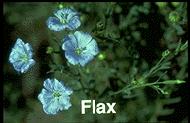Linseed oil an is amber-colored, fatty oil extracted from the cotyledons and inner coats of the linseed. The raw oil extracted from the seeds by hydraulic pressure is pale in color and practically without taste or odor. When boiled or extracted by application of heat and pressure, it is darker and has a bitter taste and an unpleasant odor. Linseed oil has long been used as a drying oil in paints and varnish. It is also used in making linoleum, oilcloth, and certain inks.
Linseed oil, obtained from seed of the flax plant, is primarily used in industry; but some is used for edible purposes in eastern Europe. The flax plant is erect growing to 3 feet, with narrow, entire leaves. The fruit is a pod or capsule, which is indehiscent. Linseed oil, obtained from seed of the flax plant, is primarily used in industry; but some is used for edible purposes in eastern Europe.
Because of the mucilage content, it may adversely affect the absorption of drugs, iron and other minerals. When taken simultaneously, bulk-forming laxatives may inhibit the absorption of other drugs (e.g. aspirin, cardiac glycosides, antibiotics, anticoagulants, etc.) and dietary nutrients (e.g. calcium, iron, zinc, sodium, potassium, etc.). Due to the diuretic action of this herb, the following drug interactions are possible: increased risk of toxicity with anti-inflammatory analgesics; if hypokalemia occurs possible antagonism with antiarrhythmics and potentiation of muscle relaxants; antagonizes antidiabetic (hypoglycemic) drugs; may potentiate and/or interfere with antihypertensives; may potentiate lithium therapy; when taken with corticosteroids there is a risk for hypokalemia; may potentiate other diuretics and increase the risk of hypokalemia.
Do not exceed 60 g internally. Do not use immature seeds. In cases of inflammatory bowel conditions, linseed should only be used after being pre-swollen. When taken in too high doses, linseed may disturb the water and electrolyte balance, resulting in excessive loss of potassium. Linseed can accumulate cadmium. Drink plenty of fluids when using linseed. Due to the bulk-forming fibers and mucilage found in this material, ingesting it without adequate fluid may cause it to swell, blocking the esophagus, and cause choking. This material should be administered with at least 8 ounces of water or other fluid (taken without enough fluid may cause choking). Seeds contain prussic acid which is potentially toxic (cyanogenic) in large doses. Leaves and the seed chaff of Linum usitatissimum contain linamarin (a cyanogenic glycoside) that liberates cyanide upon hydrolysis with linamarase (enzyme also present). Linamarin, a cyanogenic glycoside, yields hydrocyanic acid (prussic acid) upon hydrolysis. In low doses, hydrocyanic acid (HCN) may cause dizziness, headache, nausea, and vomiting. If cyanides overwhelm the body's natural detoxification mechanisms, they can stop cellular respiration by inhibiting cytochrome oxidase, carbonic anhydrase and other enzyme systems resulting in acute cyanide poisoning characterized by: hyperventilation, headache, nausea, vomiting, collapse, coma, convulsions, respiratory failure, and death. Subacute symptoms with nonlethal doses include: choking feeling, anxiety, dizziness, confusion, headache, incontinence, rapid, weak and irregular pulse.
|
